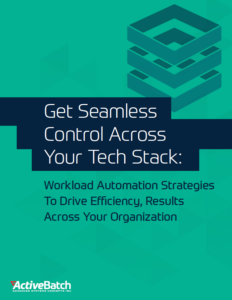API Automation Testing Is Key To Flexible, Reliable IT Automation
API integration automation is the practice of using APIs to rapidly and reliably automate processes between disparate endpoints and systems. Learn more.

API automation testing is the key to efficiently testing and maintaining properly-functioning APIs. Performance testing covers APIs that connect endpoints in four ways:
- Custom scripts
- Direct integrations
- Universal connectors
- APIs
There are pros and cons to each of these methods, with IT teams typically using a mix. For example, custom scripts can be very useful when managing connections for in-house applications (and because there’s usually someone willing to invest the time to write a really great script), but custom scripts are time-consuming and brittle.
Likewise, direct integrations can provide highly reliable connections to major platforms, but vendors can’t provide integrations for every tool in your stack. And universal connectors, while great to have on hand, typically only cover routine tasks.
What Are APIs?
An application programming interface (API) defines the function calls that a DevOps team can use to expose an application’s data. This includes local APIs such as .NET and command lines, and cloud-native web applications such as RESTful, SOAP, or WSDLs. APIs can make it easier to share data between endpoints, but can raise security and compliance issues when open APIs are used.
APIs are ubiquitous and have been around for some time. Instead of writing dozens or hundreds of lines of code, developers can use APIs that abstract away complexity by providing libraries of defined function calls. APIs also help facilitate automation initiatives, working in every stage of the lifecycle.
Today, when people talk about APIs they’re most likely referring to public or open APIs. Vendors provide APIs for a range of platforms and applications — from legacy systems and open–source software to cloud-native apps — that DevOps teams can insert into their own code in order to retrieve data. For example, the Uber app uses data from Google Maps, while marketing teams might use APIs to connect Salesforce and HubSpot, or customer service to connect Zendesk to a back-end server. It can also be used for newer container orchestration applications like Docker and Kubernetes or for cloud services like Microsoft Azure or VMware.
What Is API Automation Testing?
API testing automation is the practice of automating the functional testing of APIs for reuse. This practice is regularly performed by IT testers to ensure that the APIs are performing well and have no issues in compatibility, latency or function.
There are several test cases that are typically examined during functional testing including connectivity, compatibility and compliance with existing versions and more. Test scenarios can be developed for automated or manual testing to suit the needs of the testing framework. Dependencies are also tested to ensure all automations are flowing through APIs across applications, from open source to web apps and microservices.
Testing can also be broadened to include load testing, UI testing, security testing and software development testing. Test coverage can be as broad or narrow as the IT team needs it to be. All stages of the lifecycle can be included, including continuous integration. Monitoring test results is also a good way to spot any underlying issues and address them for debugging in a more agile manner.
Functional testing helps ensure that there are no issues that would prevent an application’s API from creating issues and potentially disrupting business operations. There are a number of different API testing tools that can be used to create a test suite, including plugin tools.
Why Is API Automation Testing Important?
API automation testing plays an important role in ensuring optimal business operations. Having an API failure can ripple out through an organization’s technology ecosystem, especially where it’s used to connect an enterprise application to workload automation tools.
When an API fails, it can cause the failure of all the automated workflows using that application. This can significantly hamper business operations, creating costly delays as well as a fire drill as IT must identify and remediate the issue.
Automation is growing in usage with IT teams using automation to address the challenges of COVID-19 and the economic disruption following. Bain & Company estimates that the number of companies making scalable automation frameworks a priority will double this year.
API Automation Testing Processes
The overall goal of API automation testing is to ensure that the API endpoints are all functioning properly. As part of functional testing, requests will be sent to the API to verify that it’s receiving and sending responses correctly.
When setting up an API automation testing procedure, there are four methods that are commonly used – GET, POST, PUT and Delete. They include:
- GET methodology: Test data is extracted from the specific server being tested with a specific URI.
- POST methodology: In the test, it makes a request, which is used to create a new entity or to send information to a server using HTML forms.
- PUT methodology: The testing is used to create or update a new or existing entity
- Delete methodology: During the test, it removes the representations of the focus resource identified by an URI
API Automation Testing For IT And Business Processes
Workload automation (WLA) platforms that provide REST API adapters make it easy to integrate any software or service with an API, whether third-party or in-house. Users can take REST API calls from any library and use those calls to build their own API. APIs can also be used in combination with direct connections, custom scripts, and universal connectors to build reliable, reusable, cross-platform workflows.
This is made possible in part by a content-sensitive script editors that support a variety of content types:
- JSON
- XML
- Raw
- URL encoded
- Binary
- Form-data
Automation platforms can help streamline REST API testing by enabling devops to test APIs within the API adapter. These API tests provide status codes and responses without having to wait for the job load to execute, so that issues can be quickly resolved without digging through logs.
Additional features and functionality such as Authentication Wizards, helpers, and intuitive UIs are making it even easier for IT teams to connect virtually any endpoint, reducing complexity and supporting IT process automation.
Adapt Faster With API Automation Testing
By implementing regular API automation testing, both IT operations and development teams can ensure that APIs are functioning correctly. It’s an increasingly critical part of IT’s responsibilities as more and more applications – and their processes – are automated.
An API automation is the use of an API as a tool to automate certain parts of a process. An API is typically used as a way to connect different enterprise applications, systems or servers to workload automation tools. This allows the seamless integration of all applications in a scalable tech stack with a centralized automation platform.
To test an API, IT teams create test scripts for specific actions throughout the operations and development lifecycle, including interactions with endpoints, sending of requests, response time and the validation of any responses. These processes can all be automated, saving time for IT teams and creating a faster, more reliable testing process.
APIs play a vital role in the automation process. REST APIs are frequently used to connect enterprise on-prem and web applications like SAP, Oracle, Microsoft and more to workload automation platforms like ActiveBatch. They play a crucial role in the reliable and secure integration of applications as part of the automation process.
API automation doesn’t always require coding. Prebuilt integrations remove the need for custom scripting. Workload automation providers use tested APIs to ensure that the application can be integrated quickly and securely.
API testing automation is the practice of automating testing of APIs. This practice helps ensure that the APIs are performing well and have no issues in compatibility or function. This helps ensure that there are no issues that would prevent an application’s API from creating issues and potentially disrupting business operations.
There are four different types of API testing – POST, GET, PUT and Delete. The GET methodology extracts test data from the specific server being tested with a specific URI. The POST methodology makes a request, which is used to create a new entity or to send information to a server using HTML forms. The PUT methodology is used to create or update a new or existing entity. The Delete methodology removes the representations of the focus resource identified by an URI.
Don’t Settle For Unreliable Automation
Improve reliability and extensibility across your environment with the right workload automation strategies and tools.








